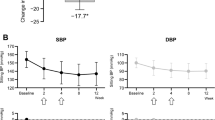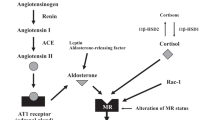Abstract
Current guidelines recommend withdrawal of treatments that affect the aldosterone/renin ratio (ARR) when screening for primary aldosteronism (PA). However, abandonment of mineralocorticoid-receptor antagonist (MRA) and/or blockers of the renin–angiotensin system can deteriorate control of blood pressure (BP) and hypokalemia. Thus, in consecutive patients with an unambiguous diagnosis of PA in washout from confounding treatments and subtyped by AVS, we will compare within-patient plasma aldosterone and active renin concentration, and the ARR values, measured at baseline, and after a 1-month treatment with MRA alone and combined with an AT-1 receptor blocker (ARB). Patients on a regular salt intake will be treated with canrenone (50–100 mg orally) for 1 month, after which olmesartan (10 or 20 mg orally) will be added for another month with up-titration of both treatments over the first 2 weeks to control BP and hypokalemia, while background therapy will be maintained. The biochemical variables and the ARR will be assessed in an identical manner at baseline values and after each month of treatment. With a sample size of 40 patients, the study will have a 95% power to show a clinically significant 20% change in the ARR at a 5% α value using a two-sided paired t test. Hence, this study will allow us to determine if an MRA alone, or added to an ARB at doses that control BP and hypokalemia, affects or not the ARR, thus allowing to establish if these agents can be administered or must be forbidden during the screening of PA.

Similar content being viewed by others
References
Rossi GP, Bernini G, Caliumi C, Desideri G, Fabris B, Ferri C, et al. PAPY Study Investigators. A prospective study of the prevalence of primary aldosteronism in 1,125 hypertensive patients. J Am Coll Cardiol. 2006;48:2293–2300.
Funder JW, Carey RM, Mantero F, Murad MH, Reincke M, Shibata H, et al. The managent of primary aldosteronism: case detection, diagnosis, and treatment: an endocrine society clinical practice guideline. J Clin Endocrinol Metab. 2016;101:1889–916.
Douma S, Petidis K, Doumas M, Papaefthimiou P, Triantafyllou A, Kartali N, et al. Prevalence of primary hyperaldosteronism in resistant hypertension: a retrospective observational study. Lancet. 2008;371:1921–6.
Olivieri O, Ciacciarelli A, Signorelli D, Pizzolo F, Guarini P, Pavan C, et al. Aldosterone to renin ratio in a primary care setting: the Bussolengo study. J Clin Endocrinol Metab. 2004;89:4221–6.
Rossi GP, Cesari M, Cuspidi C, Maiolino G, Cicala MV, Bisogni V, et al. Long-term control of arterial hypertension and regression of left ventricular hypertrophy with treatment of primary aldosteronism. Hypertension. 2013;62:62–9.
Williams B, MacDonald TM, Morant S, Webb DJ, Sever P, McInnes G, et al. British Hypertension Society’s PATHWAY Studies Group. Spironolactone versus placebo, bisoprolol, and doxazosin to determine the optimal treatment for drug-resistant hypertension (PATHWAY-2): a randomised, double-blind, crossover trial. Lancet. 2015;386:2059–68.
Williams B, Mancia G, Spiering W, Agabiti Rosei E, Azizi M, Burnier M, et al. ESC Scientific Document Group. 2018 ESC/ESH guidelines for the management of arterial hypertension. Eur Heart J. 2018;39:3021–104.
Loffing J, Korbmacher C. Regulated sodium transport in the renal connecting tubule (CNT) via the epithelial sodium channel (ENaC). Pflug Arch. 2009;458:111–35.
Michel JB, Dussaule JC, Alhenc-Gelas F, Corvol P, Menard J. Can inhibition of the renin-angiotensin system have a cardioprotective effect? J Cardiovasc Pharmacol. 1985;7(Suppl 2):S75–79.
Rossi GP, Ceolotto G, Caroccia B, Lenzini L. Genetic screening in arterial hypertension. Nat Rev Endocrinol. 2017;13:289–98.
Rossi GP, Ceolotto G, Rossitto G, Seccia TM, Maiolino G, Berton C, et al. Prospective validation of an automated chemiluminescence-based assay of renin and aldosterone for the work-up of arterial hypertension. Clin Chem Lab Med. 2016;54:1441–50.
Rossi GP, Seccia TM, Palumbo G, Belfiore A, Bernini G, Caridi G, et al. Primary Aldosteronism in the Prevalence in hYpertension (PAPY) Study Investigators. Within-patient reproducibility of the aldosterone: renin ratio in primary aldosteronism. Hypertension. 2010;55:83–89.
Maiolino G, Rossitto G, Bisogni V, Cesari M, Seccia TM, Plebani M, et al. PAPY Study Investigators. Quantitative value of aldosterone-renin ratio for detection of aldosterone-producing adenoma: the aldosterone-renin ratio for primary aldosteronism (AQUARR) study. J Am Heart Assoc. 2017;23:19–23.
Seccia TM, Caroccia B, Gomez-Sanchez EP, Gomez-Sanchez CE, Rossi GP. The biology of normal zona glomerulosa and aldosterone-producing adenoma: pathological implications. Endocr Rev. 2018. https://doi.org/10.1210/er.2018-00060
Rossi GP. Mineralocorticoid receptor antagonists: time of repositioning them in the treatment of arterial hypertension. J Hypertens. 2018;36:1015–8.
Haase M, Riester A, Kropil P, Hahner S, Degenhart C, Willenberg HS, et al. Outcome of adrenal vein sampling performed during concurrent mineralocorticoid receptor antagonist therapy. J Clin Endocrinol Metab. 2014;99:4397–402.
Author information
Authors and Affiliations
Corresponding author
Ethics declarations
Ethical approval
All procedures that will be performed in the study are in accordance with the ethical standards of the institutional and/or national research committee and with the 1964 Helsinki declaration and its later amendments or comparable ethical standards. The study will be started only after approval of the institutional Ethics Committee.
Informed consent
Informed consent was obtained from all individual participants included in the study.
Conflict of interest
The authors declare that they have no conflict of interest.
Rights and permissions
About this article
Cite this article
Rossitto, G., Cesari, M., Ceolotto, G. et al. Effects of mineralocorticoid and AT-1 receptor antagonism on the aldosterone–renin ratio (ARR) in primary aldosteronism patients (EMIRA Study): rationale and design. J Hum Hypertens 33, 167–171 (2019). https://doi.org/10.1038/s41371-018-0139-x
Received:
Revised:
Accepted:
Published:
Issue Date:
DOI: https://doi.org/10.1038/s41371-018-0139-x
- Springer Nature Limited
This article is cited by
-
Modern Management of Hypertensive Emergencies
High Blood Pressure & Cardiovascular Prevention (2022)




